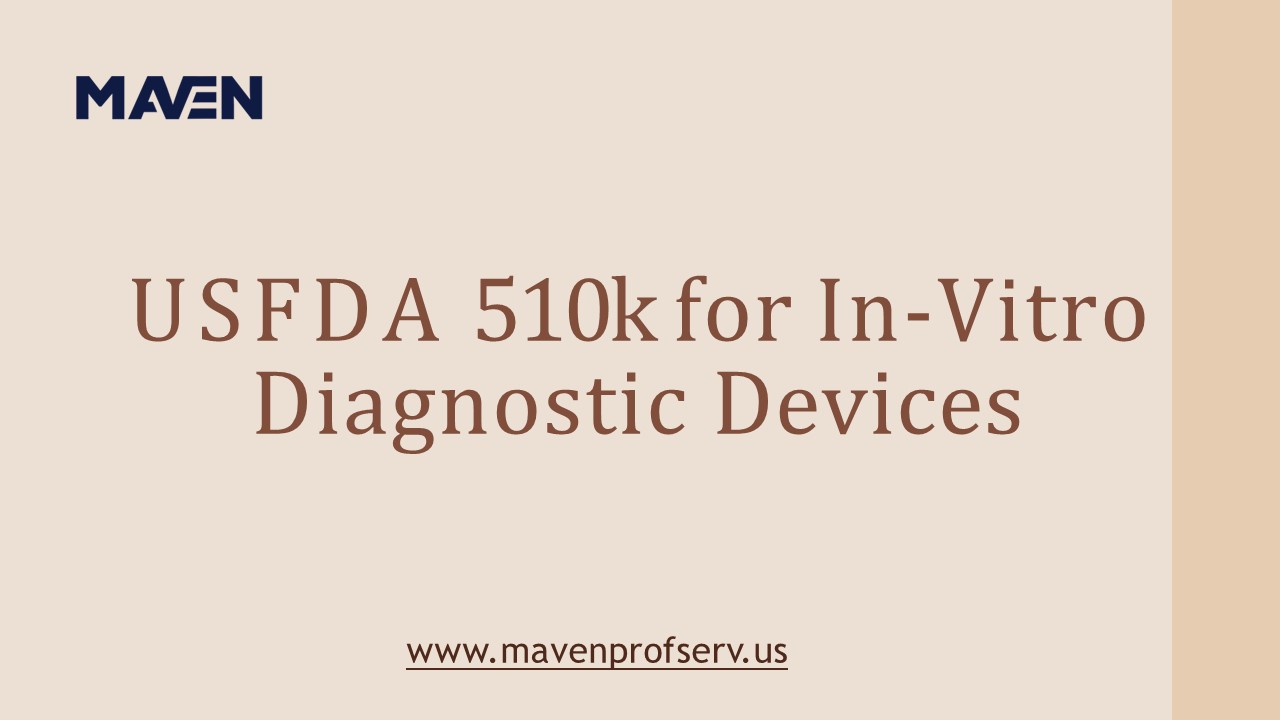Crucial Guide: USFDA 510k Path for Diagnostic Devices - PowerPoint PPT Presentation
Title:
Crucial Guide: USFDA 510k Path for Diagnostic Devices
Description:
Secure USFDA approval for In-Vitro Diagnostic Devices effortlessly. Your pathway to compliance and market success starts here! In the United States, In-Vitro Diagnostic devices require regulatory approval or clearance from the U.S. Food and Drug Administration before they can be legally marketed and sold. The specific regulatory pathway depends on the classification of the IVD device. – PowerPoint PPT presentation
Number of Views:0
Title: Crucial Guide: USFDA 510k Path for Diagnostic Devices
1
USFDA 510k for In-Vitro Diagnostic Devices
www.mavenprofserv.us
2
Overview
The primary pathways for obtaining FDA approval
for IVDs Classification of In-Vitro Diagnostic (IV
D) devices as per USFDA How can MAVEN,
consultancy for USFDA 510(k) approvals be of
assistance?
3
In the United States, In-Vitro Diagnostic (IVD)
devices require regulatory approval or clearance
from the U.S. Food and Drug Administration (FDA)
before they can be legally marketed and sold.
The specific regulatory pathway depends on the
classification of the IVD device.
4
The primary pathways for obtaining FDA approval
for IVDs
- 510(k) Clearance
- De Novo Classification Request
- Premarket Approval (PMA)
- Emergency Use Authorization (EUA)
- Laboratory Developed Tests (LDTs)
5
Classification of In-Vitro Diagnostic (IVD)
devices as per USFDA
The classification of In-Vitro Diagnostic (IVD)
devices in the United States is based on the
level of risk associated with the device.
The U.S. Food and Drug Administration (FDA)
classifies medical devices into three main
classes Class I, Class II, and Class III. The
classification system is outlined in the Code of
Federal Regulations (CFR), specifically in 21
CFR Part 862-892 for IVD devices.
6
Heres a general overview of the classification
criteria
Class I IVD Devices Low to moderate
risk. General controls are usually sufficient to
ensure safety and effectiveness. Examples
include certain general laboratory equipment,
general-purpose reagents, and simple testing kits.
7
Class II IVD Devices
Moderate risk. Special controls, in addition to
general controls, are necessary to provide
reasonable assurance of safety and
effectiveness. Examples include enzyme-linked
immunosorbent assay (ELISA) test kits, certain
blood glucose monitoring devices, and home
pregnancy test kits.
8
Class III IVD Devices
High risk. Require premarket approval (PMA) to
ensure safety and effectiveness. Examples
include certain high-complexity tests, companion
diagnostics, and devices for assessing the risk
of specific medical conditions.
9
How can MAVEN, consultancy for USFDA 510(k)
approvals be of assistance?
- Regulatory Strategy Development
- Pre-Submission Planning
- 510(k) Submission Preparation
- Pre-submission Interactions with the USFDA
- Interactive Review Process
10
- Quality Management System (QMS) Support
- Labeling and Instructions for Use
- Post-Market Surveillance Planning
- Training and Education
- Risk Management
- Compliance with Latest Regulations
- Preparation for FDA Inspections
- Customized Solutions
11
Contact Us
https//mavenprofserv.us/usfda-510k-for-in-
vitro-diagnostic-devices/
md_at_mavenprofserv.us

